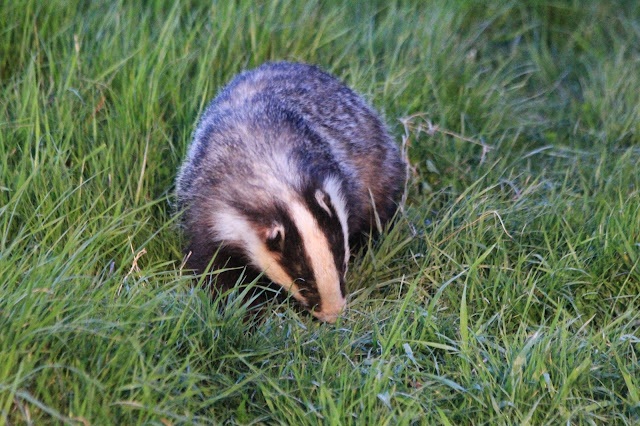Raw awe-inspiring jagged shorelines juxtaposed with
meandering streams coursing through gently rolling hills. For once, I am not
referring to Cambridgeshire. We recently took the opportunity to roam further
than usual from our local patch and spent a wonderful week in (mostly) sunny
Dorset.
It came as no surprise that we found it to be abound with
excellent habitats for all manner of creatures. From the fox who slinked across
the path in front of us on our first evening to the common lizard who posed for
us in the sun on our final morning, we were treated to a display of Britain’s
wildlife at its finest.
It is hard to choose a favourite wildlife moment from the
holiday but if I had to decide, for me, it came in a waddling, snuffling, black
and white quadrupedal form. Badgers!
The tell-tale signs of the presence of badgers were there
from the start. Although badgers are elusive nocturnal creatures, with a little
bit of detective work, it’s easy to tell whether they have a sett somewhere in
the vicinity. We first noticed that there were small tufts of wiry black hair dotted
along the road beside our cottage and, on closer inspection, we saw that there
were intermittent tracks of five-toed footprints stamped into the dried mud. So
we knew they were around, but where?
We heard that there was a place nearby with hides on site
which were known to be visited by a clan of badgers. We went along just before
dusk with high hopes but acutely aware that you just can’t predict wildlife.
The hides were set in the middle of farmland in front of a small, thickly
wooded hillock. As the sun dropped gradually to the west, leaving a magenta
blur hanging in the sky, we sat in silence, knowing that even a cough or a
shuffle could startle the badgers into staying away. I have recently been practicing my wildlife filming so I set up the camera ready, hoping that I might be able to catch some badger antics on film.
Then, as the last of the light was fading, a streak of white
appeared from the undergrowth on the hillock. A sturdy badger poked his head
out from the darkness, paused while he decided that the coast was clear and
then bumbled into the open in front of the hide and began busily rooting around
on the ground for the peanuts which the owners of the hide had scattered.
Shortly afterwards, another two badgers appeared, their silvery hair and
dazzling white stripes almost ghostly in the dusky light.
We watched for some time as they scurried around, snuffling
the ground with their stubby snouts and feeding eagerly. Sometimes one would
retreat into the undergrowth for a few minutes, before re-emerging ready for
another course. Badgers are on average about 75cm long but the five we saw came
in a range of sizes, making it relatively easy to distinguish individuals.
One of the best moments came when we saw a badger gathering
new bedding for the sett. She ripped up grass with her sharp front claws and
jumped backwards into the undergrowth, dragging it with her. The sight was both
comical and incredibly impressive. Badgers regularly collect grass, leaves,
bracken and other plant matter to line their underground setts.
Badgers are not only excellent housekeepers but excellent house
builders. Although some setts are relatively simple, some can be intricate
networks of interconnecting underground tunnels and chambers which can reach to
hundreds of metres long. These setts are usually developed by the powerful
claws of many generations of badgers from the same clan and their ingenuity
puts our building developments to shame.
After a couple of hours of watching the escapades of these
fascinating mustelids, we were left alone as the badgers wandered one by one up
the hillock, not to re-emerge. They often roam over quite a wide area in search
of food to sate their omnivorous diet, so perhaps they had exhausted their supply
of peanuts at the hide and had decided to forage further afield.
It is sad that the experience of seeing these beautiful
social animals has been tainted in recent times by the controversy surrounding
the UK culling trials. The idea that we would use a method to control bTB which
has not been proven to be humane and is reinforced by circumstantial unbalanced
evidence is incredibly worrying. The sooner that politicians start listening to
and collaborating with scientists the better. Amongst other issues, it has been
shown that culls carried out on small to medium (financially viable) scales
serve only to increase movement of badgers due to disruption of the social
structure and, if anything, this increases the transmission of bTB in the area.
Vaccinations for badgers, together with the development of an authorised
vaccination for cattle, and a rigorous programme of biosecurity measures for
cattle will lead to the best outcome for badgers, cattle and farmers.
Nevertheless, we owe it to these beautiful animals not to let the political issues mar the experience of watching and studying them. To the badgers we were nothing, they did not even know we were watching them, but to us they were ingenious and sociable, graceful yet lumbering. They provided us with a night we will never forget.
Nevertheless, we owe it to these beautiful animals not to let the political issues mar the experience of watching and studying them. To the badgers we were nothing, they did not even know we were watching them, but to us they were ingenious and sociable, graceful yet lumbering. They provided us with a night we will never forget.








